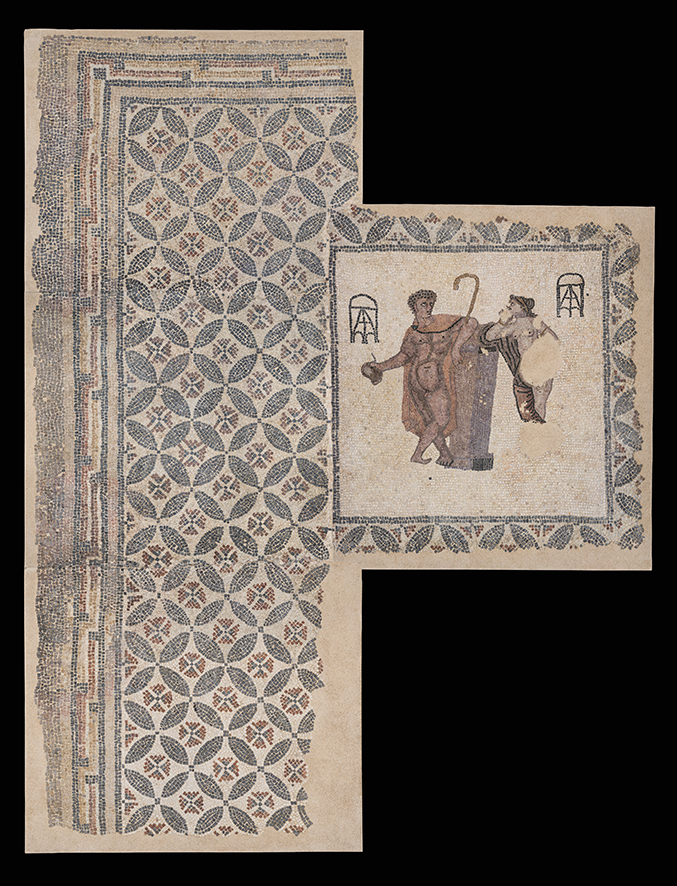
Stone tesserae fixed with mortar
3rd c. AD
Can Pau Birol, Bell-lloc del Pla (Girona - Gironès)
I am a neighbour of this mosaic. It arrived at Sant Pere de Galligants seven years before I was born in the house in the abbey garden, right in front of Sant Pere de Galligants. I cannot, therefore, symbolically separate this delicate piece from my personal memory. Saint Peter, Saint Nicholas and the house at No 1 Santa Llúcia Square form an inseparable vital triangle in my personal biography.
I evoke this personal bond to highlight my approach to the piece, which is more sentimental than academic. In the latter field, the journey from the pamphlet published by the City Council in 1993 to that published in 2016 by the Generalitat, almost twenty-five years later, marks the progress made in knowledge of the mosaics and their historical vicissitudes.
Today, therefore, with the mosaic of Theseus and Ariadne recovered and restored, we can practically rule out any past interpretations. The appreciation of an image clearly identifiable as a labyrinth without doubt places us before a mosaic dedicated to the myth of Theseus and Ariadne. In that respect, David Vivó and Lluís Palahí are quite conclusive.
I would like to highlight some aspects that fascinate me about it.
Firstly, the subtle nudity of the characters. The insinuated folds of the clothes delicately accompany the bodies of Theseus and Ariadne. Next to that, the unsolved riddle of the symbols that accompany them and the material evidence of the ball of wool that Theseus was to use to escape from the labyrinth.
Secondly, the sinuous oscillation of the story of the triple discovery of the mosaic. It was first seen in 1877, a year after the find of the iconic Circus Mosaic. It was rediscovered in 1934 by Josep de C. Serra i Ràfols. In 1941, it was re-excavated and finally extracted and moved to Sant Pere de Galligants by the same Serra i Ràfols, as explained in detail by the scholar and sage Josep M. Llorens. The in situ maintenance of the Theseus and Ariadne mosaic preserved its integrity in Girona and saved it, under provincial safeguard, from the journey undertaken to Barcelona by the Circus Mosaic.
The third question concerns its setting in a known, partially excavated Roman villa: Can Pau Birol or Bell-lloc del Pla. This the most fascinating aspect of all. Firstly due to the structuring of the territory of Gerunda and its suburbium in a scheme that we now know quite well. It tells us how the elite classes owned large suburban estates where they enjoyed the tranquillity of the countryside, welcomed guests and made business deals. Above all, however, it is the fact that the memory of the villa and its magnificent mosaics were buried below the foundations of the medieval farmhouse. It is fascinating to think that it was the work of the farmer, the ploughing of the fields and building work in the house that eventually revealed a history of two thousand years.
In that respect, we can add the ambiguity of the current T shape of the mosaic, which is largely due to the parts occupied by the farmhouse walls and the partial extraction of a quadrangular mosaic.
Finally, I return to a personal story. In my research on Joan Subias, I came across the efforts to rescue the Can Pau Birol mosaics and make them available to the public. For this we have to thank the provincial and regional government cultural services with the intervention of Subias, together with Rafael Masó and Josep de C. Serra i Ràfols. The correspondence that has emerged underlines the role of the Provincial Government (Diputació), the Regional Government (Generalitat), the Monuments Commission and the Institute of Catalan Studies.
In the middle of the nave of Sant Pere de Galligants, the mosaic of Theseus and Ariadne appears detached from the setting for which it was conceived and commissioned. It requires of us an effort of interpretation and contextualisation to transcend its intrinsic beauty and visualise it in the grandeur of a Roman villa.
Joaquim Nadal i Farreras
